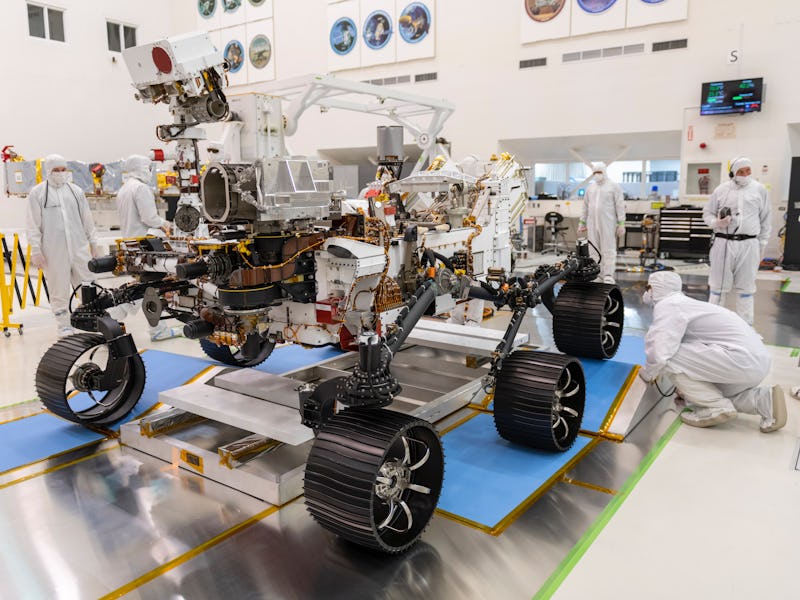Mars 2020: NASA is trusting reliable tech from the '60s for its $2.7 billion Mars mission
NASA uses a far more complex cell-phone network to communicate with rovers on Mars

NASA needs to make sure that the Perseverance rover has full bars on Mars. In order for the car-sized robot to be able to phone home, the space agency is relying on a trusty communication network built in 1958.
This Monday marks a milestone: The 10-day countdown leading toward the launch window for NASA's Perseverance rover has officially begun.
READ MORE PERSEVERANCE ROVER NEWS FROM INVERSE
But before Perseverance is actually sent to the Red Planet, NASA needs to ensure that it can keep in contact with the rover as it roams across the Martian terrain. That will be made possible via a global network of antennas known as the Deep Space Network (DSN).
The goal of the Perseverance mission is to look for clues of ancient life on Mars. These will help scientists understand the history of the planet, which is hypothesized to have once been a wet, habitable world. The rover will also collect Martian samples, stowing them away for a future return to Earth.
Sonny Giroux, program manager on the DSN for Peraton, a commercial space company working with NASA on the Perseverance mission and a subcontractor on the DSN, compares the communication to Mars to a phone call, and the network itself to a cellphone provider like AT&T, albeit significantly more complex.
"It really hasn’t fundamentally changed over the years," Giroux tells Inverse. "What has changed is the amount of information that can be sent back and forth."
Read more in our countdown series:
- 50 days to launch: The Mars Perseverance rover must solve one big mystery
- 40 days to launch: To find aliens, NASA is looking in the Nevada desert
- 30 days to launch: NASA will fly a helicopter across the Martian surface
- 20 days to launch: This is what the next generation of rovers may look like
The DSN is made up of a network of antennas spread out across the world, with this one located Goldstone, in California's Mojave Desert. California.
The DSN uses radio frequency transmissions that travel through large antenna systems with specialized receivers. The network is made up of three deep-space communications facilities in three different locations across the world, which are strategically placed approximately 120 degrees apart. One facility is located at Goldstone, in California's Mojave Desert, another is near Madrid, Spain and the third is near Canberra, Australia.
The reason behind this placement is to ensure that at any point in time, one or more of these complexes can communicate with the spacecraft as the Earth rotates around its 360 degree axis.
As the Perseverance rover takes off from Earth, NASA will use the DSN to communicate and send commands with the rocket as it launches, as the rover lands on the Red Planet and for the duration of its mission on Mars.
If NASA fails to maintain that line of communication, then the whole mission goes to waste.
"There’s no way to fix it once it leaves Earth."
"There’s no way to fix it once it leaves Earth. If it doesn’t work, it's probably not ever gonna work," Giroux says. "If we launch a spacecraft and we can’t communicate with it effectively, it’s a couple million dollars' waste of money."
Therefore, the team devises a plan of how to communicate with the spacecraft, how much bandwidth it requires and where on Earth they will be relative to the spacecraft. And because Mars is more than 67 million miles away from Earth, there's a lag in communication that's between 10-30 minutes.
That lag requires extra planning when it comes to navigating the rover's landing on Mars, which is essentially automated ahead of time. Once it enters the Martian atmosphere, NASA loses communication with the rover for a period of time known as the 'seven minutes of terror.'
"There’s a tremendous amount of planning and preparation, starts years and years in advance, to make sure the two entities can talk to each other effectively," Giroux says.
NASA has used the DSN's antennas to communicate with spacecraft since the 1960s, sending out signals to an average of 30 spacecraft a day.
In 1977, NASA launched the Voyager mission to interstellar space and has been using the DSN to stay in touch with the twin spacecraft ever since. Although, the network is now a lot more advanced.
"They were operating on 8-bit technology, it’s almost inconceivably small compared to what we have today," Giroux says. "That's where we've seen the most amount of change."
However, the technology has remained the same similar to how computers operate on the same technology but are a lot more advanced today than they were 50 years ago.
"Our computer systems back in the day were monster computer systems, and now we’ve got them on our watches," Giroux says.
Though the current radio transmission technology has been tried and tested, NASA is also looking to transition to laser-beam based communication to develop a faster, more efficient means of communicating with spacecraft.
NASA previously sent three other rovers to Mars, Spirit, Opportunity, and Curiosity, which landed on the Red Planet in August, 2012, and is still roaming the Martian surface to this day.